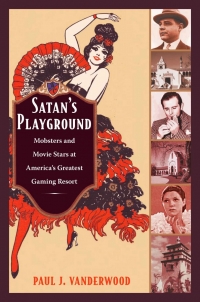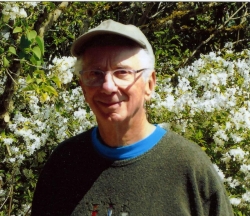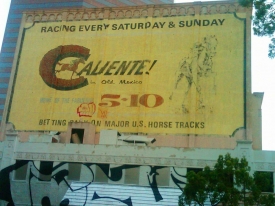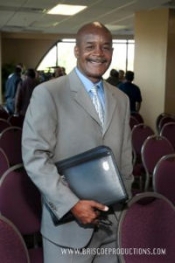 Satan’s Playground, By Paul J. Vanderwood (Duke University Press, Durham, NC, 2010, 392 pages.)
Satan’s Playground, By Paul J. Vanderwood (Duke University Press, Durham, NC, 2010, 392 pages.)
Book Review by Dennis Moore
December 23, 2010 (San Diego)--Paul J. Vanderwood’s Satan’s Playground chronicles the rise and fall of the tumultuous, lucrative gambling industry that developed just south of San Diego's border with Mexico in the early 20th century. As prohibitions against liquor, horse racing, gambling, and prostitution swept the United States, the vice industries flourished in and around Tijuana to the extent that reformers came to call the town “Satan’s Playground”-- unintentionally increasing its licentious allure to Hollywood stars and other celebrities of the era.
The area was dominated by Agua Caliente, a large, elegant gaming resort opened by four entrepreneurial “Border Barons” (three Americans and one Mexican) in 1928. Diplomats, royalty, film stars, sports celebrities, politicians, patricians, and nouveau-riche capitalists flocked to Agua Caliente’s luxurious complex of casinos, hotels, cabarets, and sports extravaganzas, and to its world-renowned thoroughbred racetrack.
Clark Gable, Jean Harlow, Louis B. Mayer, the Marx Brothers, Bing Crosby, Charlie Chaplin, Gloria Swanson, and the boxer Jack Dempsey were among the regular visitors. So were mobsters such as Bugsy Siegel, who later cited Agua Caliente as his inspiration for building the first such resort on what became the Las Vegas Strip.
 Less than a year after Agua Caliente opened, gangsters held up its money-car in transit to a bank in San Diego, killing the courier and a guard and stealing the company money pouch. Underwood, professor emeritus of Mexican history at San Diego State University, and the author of Juan Soldado: Rapist, Murderer, Martyr, Saint, weaves the story of this heist gone wrong. He includes the search for the killers and their sensational trial, which delved into the history of the often-chaotic development of Agua Caliente, Tijuana, and Southern California.
Less than a year after Agua Caliente opened, gangsters held up its money-car in transit to a bank in San Diego, killing the courier and a guard and stealing the company money pouch. Underwood, professor emeritus of Mexican history at San Diego State University, and the author of Juan Soldado: Rapist, Murderer, Martyr, Saint, weaves the story of this heist gone wrong. He includes the search for the killers and their sensational trial, which delved into the history of the often-chaotic development of Agua Caliente, Tijuana, and Southern California.
Drawing on newspaper accounts, police files, court records, personal memoirs, oral histories, and “true detective” magazines, he presents a fascinating portrait of vice and society in the Jazz Age, and he makes a significant contribution to the history of the U.S.-Mexico Border.
Included in the history of Vanderwood’s book is Jack Johnson, the first African American heavyweight boxing champion, who fled the United States charged with a Mann Act violation. Johnson ran a popular nightclub with boxing and gambling mainly for blacks just off Tijuana’s main strip. Satan’s Playground is replete with many such side stories, just as the book is replete with pictures of spectacular Art Deco and cosmic design adorning the dining room at the racetrack, as well as the Hotel Agua Caliente itself. The lighting sunbursts that illuminated the domed ceilings above the parquet dance floor with various veneers of hardwood in the casino’s dining room, along with the murals, depicted the sensuous frivolity of flapper society. After all, it was the intent of the builders of this showcase, the “Border Barons,” to proclaim it “the finest in the world.”
Actually, Agua Caliente, had an unassuming and inauspicious start, according to Vanderwood. The hot springs called Agua Caliente became a medicinal spa for rheumatics run by a San Diego doctor in the 1800s. Picnickers and carousers later frequented the site, and a hotel with a rowdy reputation emerged there before the barons transformed the fetid springs into an exquisite gaming resort. The rest of it is a splendid and rich history, intermingled with Mexican folklore and Hollywood legend.
Included in this splendid and rich history, intermingled with Mexican folklore that Vanderwood reveals, is the invention of the Caesar’s Salad, in of all places, Mexico! Alex Cardini, owner of the Fior de Italia, while experimenting with salads one day, concocted a salad which he christened his “Aviator’s Salad.” It proved immensely popular, so he renamed it in honor of his brother, Caesar.
Vanderwood tells several stories at once, lovingly, in splendid detail, and with a wonderful sense of pacing, according to Eric Van Young, author of The other Rebellion: Popular Violence, Ideology, and Mexican Struggle for Independence, 1810-1821. He combines biography, urban history, and crime narrative in a unique blend of elements to produce a robust and fascinating social history of gambling and other sorts of vice (bootlegging, prostitution, political corruption) in a particularly volatile and colorful area of the world, the U.S.-Mexico border around Tijuana, during the Jazz Age. Definitely, “Satan’s Playground.”
One particular section in Vanderwood’s book, “Hellfire and Brimstone,” seems to capture the essence of these intermingled stories, that is combined with Mexican folklore and Hollywood legend.
The author indicates that U.S. reformers had long portrayed Tijuana as Sodom and Gomorrah and urged government controls to contain the scourge south of the border. He further states in his book that authorities responded to the outcry by closing, then reopening the gates, or limiting the hours of passage-- not so much to prevent contamination by vice, but to pressure the neighboring nation for political position or economic advantage. Vice was only a pretext, but a potent and emotional one.
When Coffroth’s (Border Baron) track opened in 1916, the Los Angeles Evening Express, disgruntled because San Diego had grabbed the spotlight and was profiting from its hemispheric exposition, launched a month-long tirade against its rival, including San Diego’s embrace of horse racing below the border. The publisher characterized Tijuana as a place where, among other depravities and tragedies, “young women have gone astray, young boys are treading in the pathways of evil, mothers are on the verge of insanity, and Tijuana’s shame is San Diego’s shame.” The perception of the area has not changed that much since then! The publisher then went on to unload on San Diego itself, according to Vanderwood: “The San Diego newspapers have been muzzled, the city is overrun with thieves, grafters, and gambling is flourishing on an extensive scale.”
After such accusatory finger-pointing by the publisher himself, the first piece in the long series began, “If you were searching for the filthiest cesspool that ever defiled the face of the earth, you would [travel to Tijuana]. The miasma of the cesspool arises like a withering blight and assails your nostrils with its deadly stench.” And worse, “Tijuana, with its cutthroat Mexicans, its smug American gamblers, and its thieves and prostitutes of all nations, snuggles complacently …[near San Diego].” Mind you, this is Vanderwood’s characterization and perception by the publisher in the 1920s.
Vanderwood also indicates xenophobia of the Los Angeles publisher, noting that sharply etched racism branded the reportage: “Here are three white women and a negro man. They are giving him a silver to bet on the horse they fancy will win,” the Express’ contended. “Here is a negro woman talking to a white man. Yonder is a slender negro, as black as Jack Johnson, wheedling money from two Castillian girls who are badly over-dressed. The negro is clad in white flannels and his eyes gleam like coals of fire.” Example after example saturated the newspaper’s columns from San Diego’s natural altruistic rivals in LA.
 Being from Chicago and having lived for years in Tijuana, and once writing for a Mexican newspaper in Rosarito Beach, I can certainly appreciate the insight and rich cultural history that Vanderwood has shared with us in this fantastic book, Satan’s Playground. I see remnants of the Agua Caliente Racetrack and its once grand era, in the numerous Caliente off track (OTB) betting parlors strewn throughout Tijuana, where Americans from across the border come habitually to place their bets. There is actually a huge billboard on the corner of 3rd & C Street in downtown San Diego of an advertisement from that era, some 75 years ago, advertising Agua Caliente Racetrack.
Being from Chicago and having lived for years in Tijuana, and once writing for a Mexican newspaper in Rosarito Beach, I can certainly appreciate the insight and rich cultural history that Vanderwood has shared with us in this fantastic book, Satan’s Playground. I see remnants of the Agua Caliente Racetrack and its once grand era, in the numerous Caliente off track (OTB) betting parlors strewn throughout Tijuana, where Americans from across the border come habitually to place their bets. There is actually a huge billboard on the corner of 3rd & C Street in downtown San Diego of an advertisement from that era, some 75 years ago, advertising Agua Caliente Racetrack.
In a bit of personal insight about the book and Tijuana, a Mexican friend of mine from Mexico City, now living in Tijuana, told me that Tijuana has no cultural history or identity of its own, as the city has been Americanized and basically is made up of people from all over. As a matter of fact, Tijuana’s recently elected mayor, Carlos Bustamante Anchondo, was born in the United States (National City).The author points out that present day Tijuana is much changed since the Jazz Age days of Agua Caliente, but honky-tonks on Avenida Revolucion continue to amaze and excite tourists.
Vanderwood states assuredly, “The world of the Border Barons is forever lost. Nevertheless, an aura of these colorful, unscrupulous go-getters, along with that of their vain habitués, the mob, and airy wraiths, still hovers over the scanty remnants of the once resplendent, world-famous spa. And it is true that, despite the crafted pretentiousness of the place and the insatiable self-glorification of its owners and most celebrated patrons, one rather wistfully recalls Agua Caliente as a playground one wishes to have known.”
Satan's Playground is a truly fascinating book of historic importance that I highly recommend.
 Dennis Moore is a member of the San Diego Writers/Editors Guild. He is a freelance contributor to the San Diego Union-Tribune Newspaper, and has written for LifeAfter50 Magazine in Pasadena, California, and the Baja Times Newspaper in Rosarito Beach, Mexico. Mr. Moore can be contacted at contractsagency@gmail.com or you can follow him on Twitter at: @DennisMoore8.
Dennis Moore is a member of the San Diego Writers/Editors Guild. He is a freelance contributor to the San Diego Union-Tribune Newspaper, and has written for LifeAfter50 Magazine in Pasadena, California, and the Baja Times Newspaper in Rosarito Beach, Mexico. Mr. Moore can be contacted at contractsagency@gmail.com or you can follow him on Twitter at: @DennisMoore8.







Comments
Satan's Playground
Wow! I enjoyed your review. It aroused all my emotions. I'm assuming the smug American gamblers were an intricate addition to the cut throat Mexicans in the stench filled cesspool of Tijuana. Xenophobia is an understatement. I' m surprised "Mexican" was used as opposed to "spic " "greaser" or "wetback "
MEXICO WINS GOLD MEDAL
Tijuana and all of Mexico now has more to celebrate, winning the Gold Medal in soccer.
Paul Vanderwood''s "Satan's Playground"
Paul Vanderwood will be one of many authors having their books on display at the San Diego Public Library 45th Annual Author's Exhibit and Reception at the downtown library on Friday, January 28, 2011.
SATAN'S PLAYGROUND
Another great review by Mr. Moore. Being a historian myself, the subject matter immediately caught my interest. Combining the many elements Vanderwood did in one book is fascinating and I'm looking forward to seeing how he weaved them altogether. I'm also curious to see how many more trivia facts are waiting to be discovered; such as the Caesar Salad being named after Caesar Cardini and not the emperor of Rome. Sounds like a tremendous book and Dennis Moore brought it to life for me in his review.
satan's playground
Hello Darryl, Well, when you get a chance to read the book, please let me know what you think of it. I am pretty thick skinned, so let the comments fly. I often find them helpful for my next endeavor. Much appreciated, Paul Vanderwood
Satan's Playground
This excellent review draws a picture of an era teeming with all the elements of a good story--gambling, prohibition, movie stars, crime. The review definitely makes me want to read the book.
Linda Loegel, Author of "Bumps Along the Way."
Satan's Playground
Linda,
As an author yourself, you probably appreciate comments from readers on your work. I certainly do so. Therefore, if you get a chance to read Satan's Playground, please pass on to me your thoughts about the book. And I am reasonable thick skinned about such matters, so let the comments fly. Much appreciated. Paul Vanderwood
Great review. It's amazing
Great review. It's amazing how little people in San Diego about local history and this is certainly a good step in changing that.
It's hilarious that the Gaslamp/Stingaree is ballyhooed as an old west sin hole, when Tijuana is right there with legacies of weirdness.
My book "Imaginary Lines", touches on the "demi-monde" in Tijuana and I can't wait to read this.
And I agree, it would make a fantastic movie.
http://linrobinson.com
Satan's Playground
Hello Linton,
When you get around to reading Satan's Playground, I hope you will take a few moments to send me your reaction--your comments on the book. As you know, they can always be better. And productive comments help authors to improve. Several have suggested the book be made into a movie, and I hope that some producer picks up on that suggestion. Who knows?
"Satan's Playground"
Former Illinois Governor Dan Walker, author of "The Maverick and The Machine," emailed me with his comments regarding my review:
"An excellently written and interesting review. I compliment you highly. In the 1930s, with my father, I often visited the Agua Caliente resort and race track. I remember vividly the casino, where they used silver dollars rather than chips.
People in San Diego and elsewhere across the nation believe that Tijuana and Rosarito are like Juarez because the media has totally failed to distinguish among the Mexican cities. Anyway, I have great memories of that area about which you wrote in your book review. And I compliment you again on your review which I greatly enjoyed." GovDan